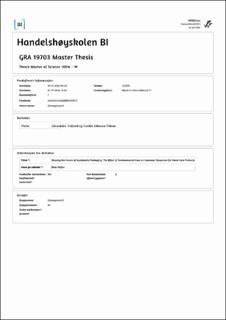| dc.description.abstract | Inspired by the continuously evolving changes that are happening within the field of sustainable packaging, this thesis examines the way packaging material and eco-labeling as environmental cues affect consumers' purchase intentions for home care products. We hypothesize that these cues lead to increased purchase intention, mediated by the consumers’ perceived environmental friendliness of the product. We further argue that the effect of the environmental cues on perceived environmental friendliness is moderated by the consumers’ green product knowledge, while environmental concern moderates the relationship between perceived environmental friendliness and purchase intention.
The results from a between-subject experiment reveal that the use of carton as packaging material both leads to higher perceptions of environmental friendliness, as well as stronger purchase intention, than the use of plastic. The same effect was not found for the presence of an eco-label, contrary to our hypotheses. The relationship between carton as product packaging and purchase intention was fully mediated by perceived environmental friendliness, while no mediation was found between eco-labeling and purchase intention. Partial statistical support was further found for our hypothesis on green product knowledge moderating the effect of the environmental cues on perceived environmental friendliness. We found that this effect depends on the condition of exposure, as a significant difference in perceived environmental friendliness between consumers with high and low knowledge was only found for the condition of carton and eco-labeling combined. Finally, we did find that environmental concern positively moderates the relationship between perceived environmental friendliness and purchase intention.
This thesis is, to the best of our knowledge, the first of its kind to explore the use of environmental cues in this specific context. As such, it provides valuable theoretical and practical implications. The results indicate that not all environmental cues are as effective as first predicted, indicating that brand managers should carefully evaluate what they wish to signal, and which cues they should implement accordingly. The thesis further adds valuable insights on consumer perceptions and the drivers behind them that are useful when developing marketing strategies for product packaging and supporting market communication. | en_US |
